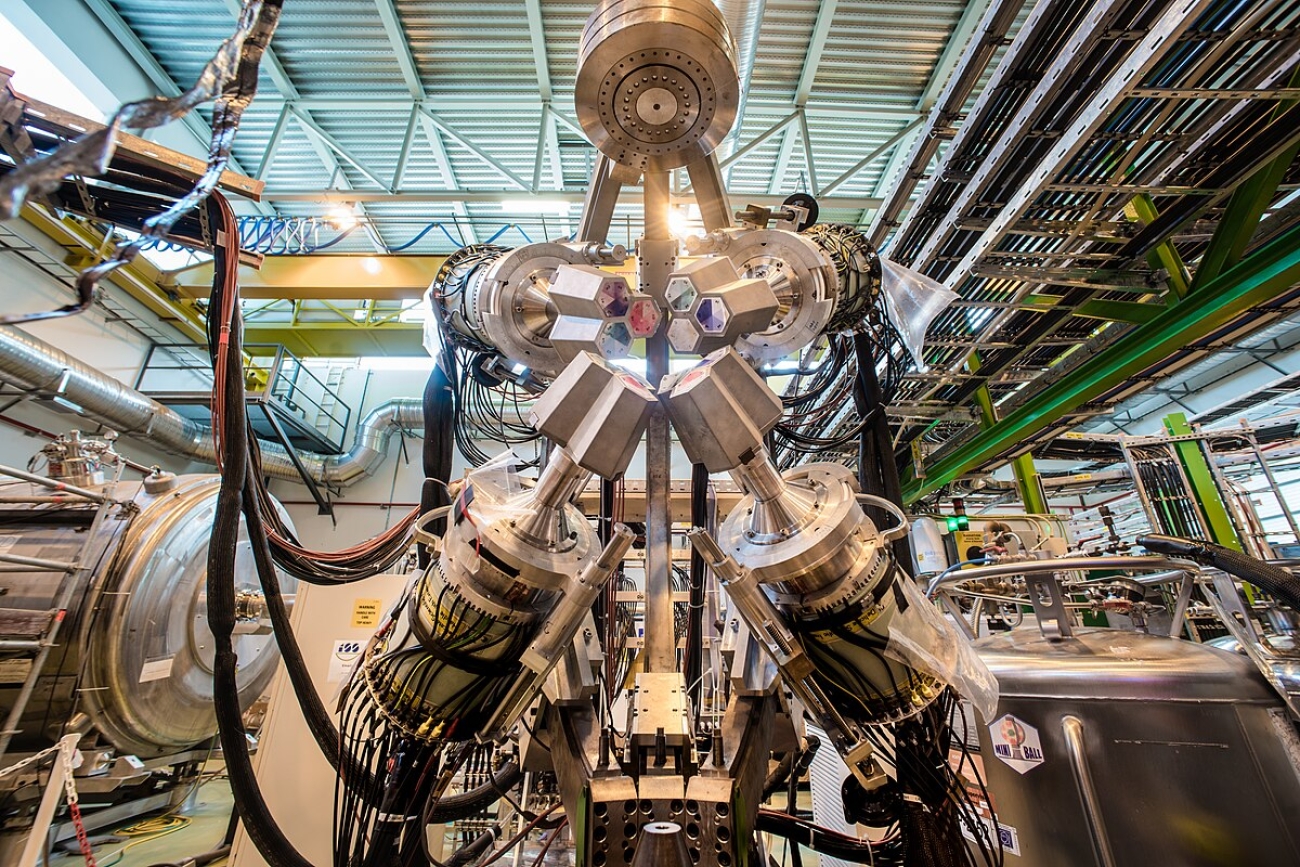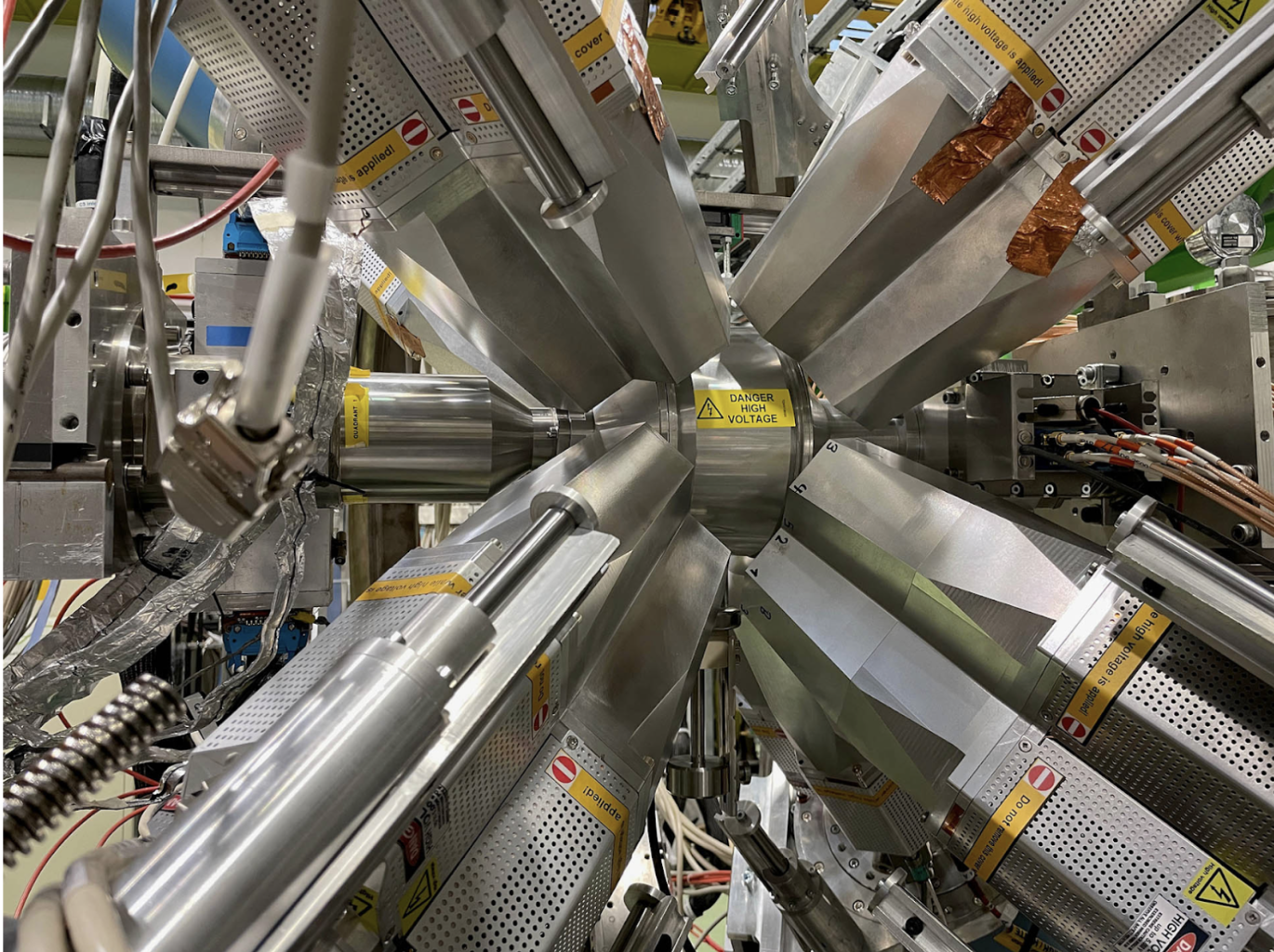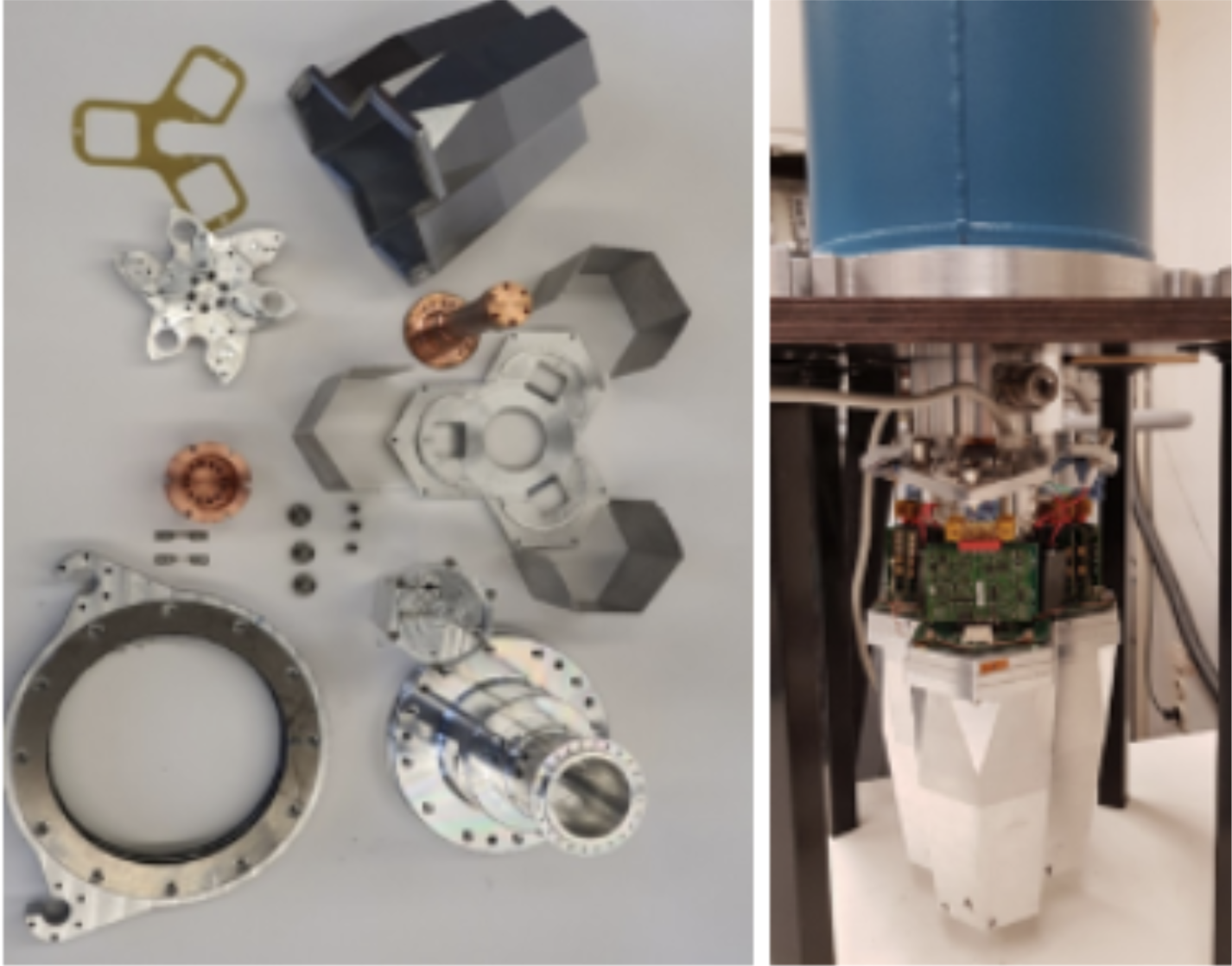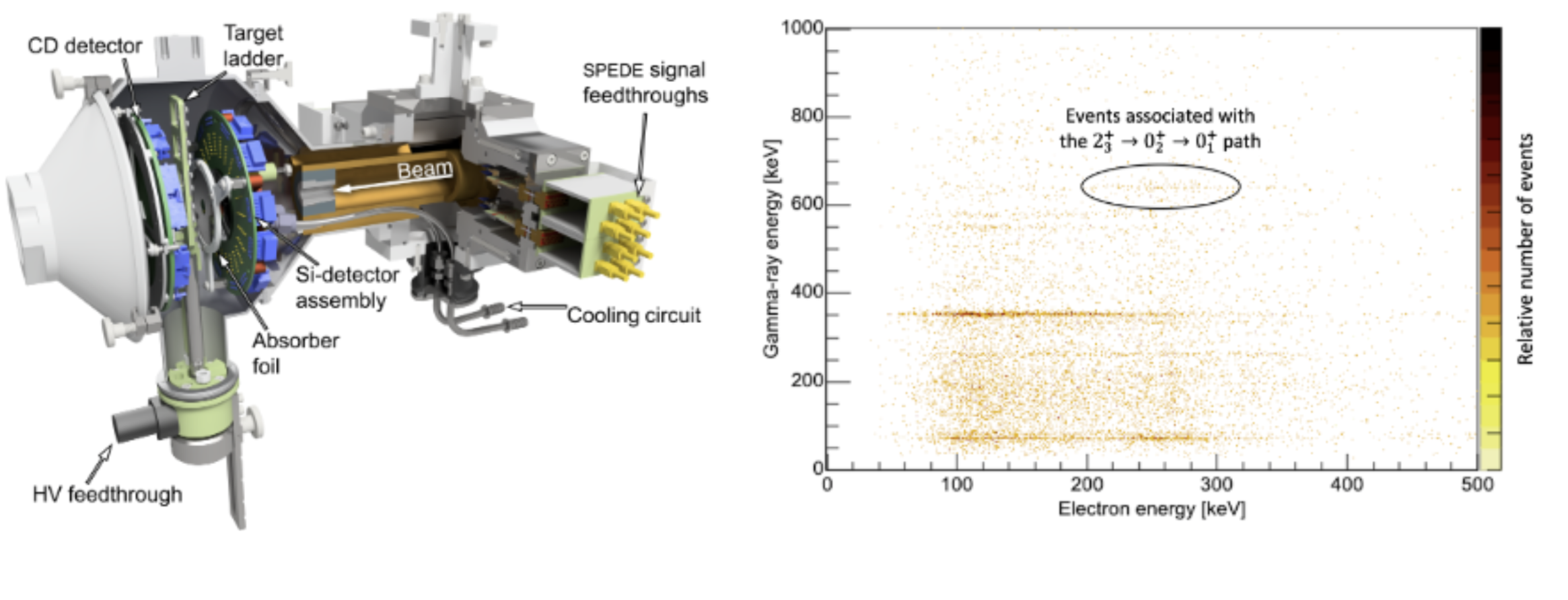Investigating exotic structures of exotic nuclei with Miniball

Atomic nuclei come in all manner of shapes and sizes, sometimes at the same time! The reason behind this diversity lies in poorly understood nuclear forces. Many features of these forces only came to light when studying very unstable nuclei, which do not occur terrestrially. At CERN, the ISOLDE facility [1] is capable of producing these unstable nuclei at high intensities. The structure of the unstable nuclei is studied with a multitude of experimental equipment.
A prominent device in ISOLDE’s arsenal is the Miniball spectrometer, an array of twenty-four high-purity germanium (HPGe) crystals for gamma-ray detection, shown in Fig. 1.

Figure 1: One hemisphere of the Miniball array surrounding the target chamber. Visible is the triple-cluster configuration of each assembly housing three HPGe detectors of hexagonal shape.
Miniball is stationed at the first experimental station of the HIE-ISOLDE beam line [2], which accelerates unstable nuclei up to ~10% the speed of light. A challenge associated with conducting gamma-ray spectroscopy at such speeds is that the energies of the gamma rays are shifted according to the Doppler effect. An innovation of the Miniball spectrometer is the electronic segmentation of its crystals, which provides information about the gamma-ray interaction position, allowing for the reconstruction of the gamma-ray energy in the laboratory frame.
There was no rest for Miniball during LS2, as it embarked on a round-the-world journey starting at the Paul Scherrer Institut (PSI), Switzerland, where it studied, among other things, X-rays emitted from muonic atoms. It then went on to the Radioactive Isotope Beam Factory (RIBF), RIKEN, Japan, where it measured gamma-rays emitted from very unstable nuclei travelling at around 60% the speed of light.
Whilst in operation, the array must be kept at cryogenic temperatures, under high voltage, and at low vacuum. To maintain excellent operational performance under such demanding conditions, following their return and after two decades of operation, the Miniball detectors were due for an overhaul. Everything from the encapsulation of the bare HPGe crystals to the amplification electronics and liquid nitrogen dewars were replaced with new components, shown in Fig. 2.

Figure 2: (left) Components of the new Miniball cryostats, designed and manufactured during LS2. (right) A fully constructed Miniball cluster detector.
In parallel to the refurbishment of the crystals themselves, the data-acquisition system was also undergoing a radical transformation. During its pre-LS2 days, the signals of Miniball were processed using a digital readout system, whereas its ancillary devices, such as silicon-strip detectors, had to be processed via an analogue chain, shown on the left of Fig. 3. As well as complicating circuitry and off-line data analysis, it was difficult to expand this system to incorporate other devices. To unify the data acquisition, a fully digital system based on the FEBEX digitisers from GSI was developed. The FEBEX cards are very compact, and just two crates are more than sufficient to accept all signals of the standard Miniball setup, shown on the right of Fig. 3. Moreover, the firmware of the cards is completely customisable, and is being actively developed by the STFC Daresbury Laboratory in the UK. This flexibility opens the door to more sophisticated pulse-shape analysis and experimental configurations.

Figure 3: (Left) Pre-LS2 data acquisition. (Right) New FEBEX modules, partially cabled.
Following its return to ISOLDE in the spring of 2022, no time was wasted in getting Miniball up and running, ready to take the beam in the summer. To kick off the physics program of Miniball an experiment aimed at probing the collective motion of neutrons in tin isotopes close to the doubly magic 132Sn was conducted. This was followed by searches for signatures of co-existing nuclear shapes in very light isotopes of mercury, and being rounded off by an investigation of the nature of proton-neutron interactions close to 132Sn.
The study of the mercury isotopes required the first use of a novel detector for electrons, which are emitted in special decay modes of nuclear excited states. The “SPectrometer for Electron DEtection” (SPEDE) [3] was successfully used as the first instance of the measurement of conversion electrons from a radioactive nucleus without the need of transport magnets. A schematic of SPEDE is shown to the left of Fig. 4 and evidence of electron detection on the right. The possibility of observations of previously undetectable transitions opens new avenues of exploration of exotic nuclear structures, especially those relating to shape co-existence.

Figure 4: (Left) Rendering of SPEDE and chamber. (Right) Preliminary spectrum showing the detection of conversion electrons in coincidence with gamma rays.
Building on the success of the 2022 campaign, the 2023 run has seen a broader scope of physics challenges addressed. This is in part owing to developments in the data acquisition system to process higher event rates, and in part owing to the adaptability of the beam line. Experiments have now been conducted on heavy isotopes of zinc, indium, tin, barium, and antimony, as well as other light isotopes of mercury. These experiments aim to address novel aspects of nuclear collective motion, including ellipsoidal and octupole (or “pear-shaped”) modes. Other aims are to investigate the form and strength of neutron-neutron and proton-neutron interactions close to the doubly magic mass-132 tin isotope.
It has been a busy couple of years for Miniball with a lot of mechanical work required for the detectors’ refurbishment, installation, and operation. Moreover, the development required for the data acquisition was significant, and improvements continue to be made based on user needs. It is natural to consider what the future holds for Miniball now that the present has been discussed.
Predominantly, the experiments discussed in this newsletter have utilised the “Coulomb excitation” technique, whereby incoming nuclei pass close to a target and become excited via the Coulomb interaction. This is a powerful technique, and requires a relatively simple configuration. However, in the past, Miniball has also been used to study reactions where the incoming nuclei undergo nucleon swapping reactions with the target. Such experiments have typically been performed with the T-REX [4] array of silicon detectors, which surrounds the reaction target to detect reaction products. A successor to T-REX is under development, which will feature, like its predecessor, a large number of channels, which can be read out by so-called “ASIC” (application-specific integrated circuit) chips. Such readout systems have proved successful in application to silicon-strip arrays with numerous channels, such as the ISOLDE Solenoidal Spectrometer [5].
On its return, the Miniball array has already got off to a running start through carrying out a range of experiments addressing diverse physics questions. This diversity is set to increase through developments of ISOLDE beams and Miniball capabilities, and translate into substantial impact through the dissemination of exciting physics results.
Read more
[1] https://home.cern/science/experiments/isolde
[2] https://home.cern/news/news/accelerators/ls2-report-first-beam-inside-u…
[3] P. Papadakis, et al., The European Physical Journal A 54, 42 (2000)
[4] Bildstein, V., Gernhäuser, R., Kröll, T. et al. T-REX. Eur. Phys. J. A 48, 85 (2012).
[5] ISOLDE's Solenoidal Spectrometer (ISS): a new tool for studying exotic nuclei [EP newsletter, March 2022]
